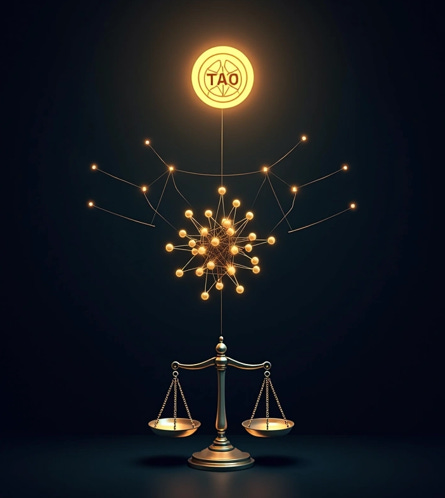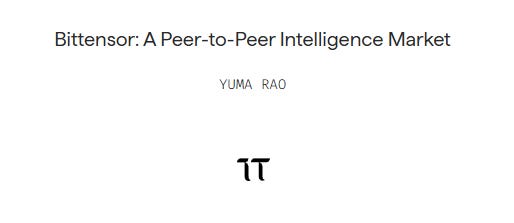A Newbies Take on the Bittensor Whitepaper
Yuma Rao = Satoshi Nakamoto?
I've read the Bittensor whitepaper. Its pretty short, so I read it a few times.
Its a slow read for an AI enthusiast unless they have a big grasp on machine learning and blockchain incentives.
As I upskill on Python and a roadmap forms in my head for contributing to a decentralized AI ecosystem, I realize this has to be tied into a Bittensor deep dive from the beginning.
Even when I don't think I'm ready.
So, what better place to start:
We'll leave the mind bending dTAO whitepaper to another day when I may be able to grasp it further.
The intro pulls me in… "We propose a market where intelligence is priced by other intelligence systems peer-to-peer across the internet".
A simple statement with profound implications.
Understanding that the setup of machine learning intelligence is biased towards large corporations taking all the slices of the pie is a red flag to anyone who values agency in their life.
My fear is that, as is right now, AI is open, helpful and collaborative (thanks for all your great relationship advice Chat GPT) but the infrastructure is drifting toward proprietary moats and closed incentives.
The risk is that the same tools that powered connection will eventually be used for control when only a few large corporations (heavily AI-driven) are left standing, with the dystopian end game leaving a cabal of too big to fail corporations or even governments left with ultimate control.
Before we veer off into a dystopian sci-fi biopic lets roll back to what we can do about this:
A peer-to-peer network of computers that monetize machine intelligence work by turning AI development into a decentralized economy.
The Model
The goal of the Bittensor network is to create a decentralized, self-regulating network, where AI models collaborate and compete to get better.
This is done in three ways:
1. Letting models vote on each other's performance (ranking score stored on a blockchain)
2. Incentivizing better performance through rewards
3. Reducing miner collusion by measuring how much each peer actually helps the network
The Incentive
The incentive function ensures miners only get rewards if they're not part of the majority consensus (>50% of the total staked TAO), so they cannot game the system.
This combines the ranking score and the consensus score, with the miners outside the majority (consensus) getting exponential rewards for improving and earning the trust of the majority.
To me this is a genius way of helping the collective intelligence grow and not just those with the most stake or existing connections in the network.
Bonds
To improve the incentive system further, miner rewards are based on both performance and bond investments.
Bond investments are like bets miners make on other models, if the model becomes more valuable the bettor's profit (stake) grows over time. Think of it like buying stock in a company, if you do your due diligence like Warren Buffett and invest well you can compound those gains over time.
The miners' overall reward is split between 50% performance and 50% bond investments, so along with improving model performance this forces miners to speculate wisely with their votes à la Buffett and align incentives with the network's long-term health.
Reaching Consensus
The system dynamically adjusts to reward unity among honest miners and prevent dishonest miners from uniting themselves to dominate rewards.
This is achieved by enforcing more weight assignments on miners (making them vote more) if a stage is reached where rewards are going to miners not trusted by the majority. This encourages the honest miners to vote for each other and then build a majority consensus.
The network is self-organizing with miners constantly sharing data and models to improve collectively, voting on each other's value through weights and bonds and ensuring rewards flow to the highest quality models.
Tensor Standardization
All models produce outputs that others can use, but models run for different purposes will find it hard to evaluate each other's work.
Think about different models focused on text generation, image processing or speech recognition- how on earth can they understand what each other is doing?
Tensors are multi-dimensional arrays (like spreadsheets) that the Bittensor network uses to standardize how all models encode their inputs and outputs, as they each must output tensors in a fixed shape specified by the network.
This creates a universal language for all models and allows peer evaluation to occur.
Conditional Computation
As the network grows and more miners join, every miner would need to share data with everyone else, which is woefully inefficient and would slow down the system due to massive network traffic.
Bittensor conditional computation uses a smart filtering system so each miner only listens to a relevant peer for a given task, not overloading the system by querying every model.
This results in miners competing to be chosen for a specific task and the system learns who is most useful over time, like a self-improving recommendation engine.
Think of the Netflix algo that after some time knows your new favorite TV series before you even watch them. Who would have known that Breaking Bad was so good?
Knowledge Extraction
Models depend on each other's outputs to solve tasks, so if a model goes offline the network will break. All miners need to be constantly connected to work which is inefficient and risky for scalability.
To counteract this KL divergence is used to create a smaller model that can mimic the main model's outputs without needing real-time communication.
This is like coaching a really nerdy student that learns everything they can from the teacher and can take over when the teacher is unavailable.
The distilled version of a model (the "student", a pre-trained proxy) can be used when the main model is offline or can be run locally when a miner does not want to share sensitive data with the network, enhancing privacy if required.
The Takeaway
To my mind, I can see a path to Bittensor succeeding because it has defined how decentralized systems can value and aggregate intelligence.
There is a self-sustaining system here where miners compete and collaborate to maximize rewards that is enabled by integrating with blockchain, which until now has been largely limited to financial transactions and not the computation heavy tasks needed for machine learning training and inference.
What a gift to the world and lets hope Bittensor continues to prosper!
Coding is Hard
As a quick update on my coding journey, I've spent the week working on loops, lists and understanding how to import external libraries.
Early days but I need to get the basics right, with the goal of eventually (hopefully not in the distant future) working with the Bittensor SDK.
More on my coding journey on another week.
That's all for this week folks, if you have any tips or advice to give please share, or for my limited perspective feel free to reach out.
Cheers!
Brian




